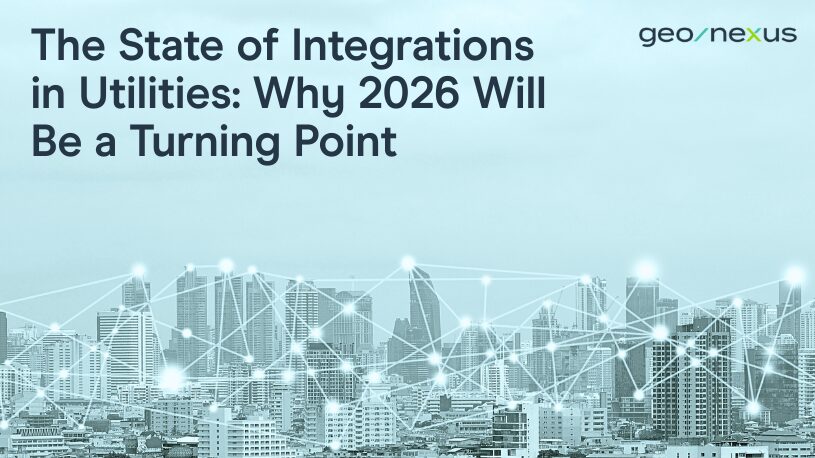
New technology is arriving faster than your systems talk to each other. Asset management, GIS, customer information systems, outage management tools generate critical data, but rarely do they operate as a single source of truth. That lack of harmony comes at a cost: lost productivity, duplicated work, bad data, and stalled projects. As we finish out 2025, integration is no longer a buzzword—it’s a business requirement.
In this industry snapshot, Geonexus explores the State of Enterprise System Integrations in the Utilities Industry, looking at what drives demand, what changed from the early days of point-to-point, and how utilities are redefining integration to support modernization, efficiency, and resilience.
The utility sector is in a crunch:
Yet most utilities still rely on siloed systems. For example, a valve record updated in GIS may take days—or weeks—to reflect in Maximo, SAP, or EAM systems. Field crews often manually re-enter work order data. Data discrepancies snowball. And when it comes time to upgrade a core system, legacy integrations break. It’s not just inefficient. It’s unsustainable.
The shift to smart infrastructure, predictive maintenance, and cloud-hosted platforms has exposed a gap: utilities need integration, not as a one-time project, but as an always-on foundation. The goal? Real-time, transparent, cross-system data alignment.
For decades, point-to-point integrations were the go-to approach. You had two systems? Build a hard-coded pipeline to connect them. That worked—until it didn’t.
Today, utilities typically run:
With point-to-point, every new connection adds exponential complexity. A change in one system can break six others. When that happens, IT teams get buried in support tickets. And when it’s time for an upgrade (S/4HANA or Esri Utility Network), everything grinds to a halt.
Utilities are recognizing this and moving toward platform-based integration models. The shift is from “build” to buy and configure.
Enter the Integration Platform as a Service (iPaaS) or, more specifically for utilities, productized integration platforms. These solutions are pre-built, fully supported platforms that simplify how enterprise systems connect. The Geonexus Integration Platform (GIP), for instance, provides a low-code/no-code platform with pre-built connectors that:
This approach gives utilities’ IT departments confidence to:
In short, they’re able to trade custom scripts for sustainable, scalable connectivity.
The demand for integration isn’t theoretical, it’s operational. Across the U.S. and Canada, utilities are initiating or accelerating integration efforts to enable:
These projects are not driven by IT, they’re driven by operations. Integration is no longer just “backend plumbing.” It’s enablement of business continuity and resilience.
In the past, integration success meant “data is moving.” Today, utilities are defining success differently:
And critically: Will this integration reduce the burden on my internal team?
As workforce gaps grow—driven by AI, retirements, hiring freezes, and competition for tech talent—utilities are increasingly strained to maintain service levels. Many GIS, IT, and asset teams are operating with fewer people than they had five years ago. In this environment, integration strategies must lighten the load. That means fewer manual processes, faster validation, and less dependence on custom code maintained by a single person.
One shift Geonexus sees is strategic utilities moving away from reactive integration (“connect system A to B”) to proactive (“ensure data resilience across my enterprise”).
That means building for:
In short, integration is becoming a core part of digital risk management.
The Director of Operations cares about ROI, reporting accuracy, and field productivity. Integration enables this role to eliminate redundant processes and respond to regulators faster.
The GIS Director wants seamless syncs from GIS to asset systems—without displacing his team.
Integration platforms let him reduce scripting needs and protect data integrity.
The GIS Manager focuses on interoperability between GIS and Maximo or SAP. He values preview mode and detailed data change reporting, like features in the Geonexus Integration Platform.
The Core Systems Manager evaluates integrations for risk, system load, and security. She needs the version-proof, compliant, and auditable data syncs of a more modern integration platform.
The Director of IT prioritizes strategic alignment, cloud compatibility, and vendor support. He’s perpetually on the lookout for low-code/no-code platforms that reduce total cost of ownership.
Each team member plays a role in the modern integration journey—and everyone benefits from integration platforms that reduce risk and increase control.
Utilities that adopt platform-based integrations are seeing:
However, many utilities remain in earlier stages of integration maturity. Those that haven’t adopted integration platforms—or are midway through implementation—continue to rely on brittle middleware or outdated, custom-coded integrations developed over a decade ago. There’s significant ground left to cover.
Looking ahead to 2026, we expect to see:
The stakes are rising. And integration is the lever.
Imagine launching a new customer portal without worrying if the data is reliable. Or upgrading GIS without breaking your EAM. Or deploying mobile apps that actually write back to core systems. This is the promise of modern integration. The question isn’t “should we integrate?” It’s “how can we integrate in a way that reduces risk, accelerates modernization, and builds data trust that lasts?”